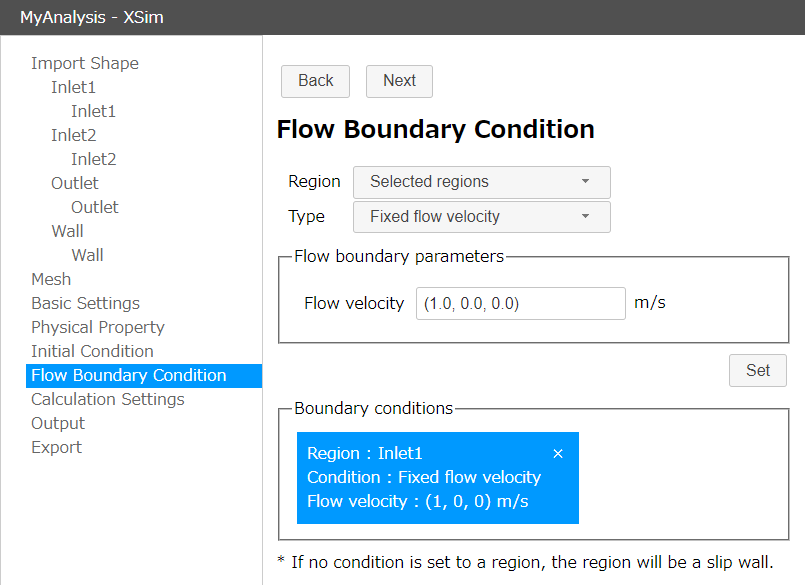Boundary condition setting
In XSim, you can set the boundary condition to the analyzed shape's region in the "Flow Boundary Condition" page. Select the region in navigation view on left side of the window and click button to set the boundary condition.

The boundary conditions that can be set are as follows.
| Boundary condition | Description |
|---|---|
| Fixed flow velocity | Sets the flow velocity at the region as a 3-dimensional vector. The unit is m/s. |
| Fixed mass flow rate | Sets the flow rate through the region in mass. The unit is kg/s. |
| Fixed volume flow rate | Sets the flow rate through the region in volume. The unit is m3/s. |
| Fixed normal direction velocity | Sets the flow velocity at the region as a scalar value. The direction of the flow is normal to the region. The unit is m/s. |
| Fixed static pressure | Sets the static pressure at the region. The unit is Pa. |
| Fixed total pressure | Sets the total pressure (=static pressure + dynamic pressure) at the region. The unit is Pa. |
| Natural inflow/outflow | Set the region as a surface with inflow/outflow can be occur. Either inflow or outflow is determined by the calculated flow near the surface. |
| Slip wall | Sets the region as a frictionless wall. |
| Stationary wall | Sets the region as a wall with zero velocity. |
| Moving wall | Sets the region as a wall with a constant velocity. The velocity is set by a 3-dimensional vector in m/s. |
| Rotating wall | Sets the region as a wall with a constant rotational speed. This is defined by the rotation axis and the rotation speed (in °/s). This condition is usually used to set a cylindrical or spherical region. |
| Symmetry | Sets the region as plane of symmetry and the exact same flow is occurring in reverse from the opposite side. |
| Boundary face mapping | Sets the pair of region and the flow velocity and pressure on one region will be mapped to the other. |
For thermal analysis, the following thermal boundary conditions can be set to the walls (slip wall, stationary wall, moving wall, and rotating wall).
| Boundary condition | Description |
|---|---|
| Adiabatic | Sets the wall to be insulated with no heat transfer. |
| Fixed temperature | Sets the wall to keep a constant temperature. The unit is K (Kelvin). |
| Fixed heat flux | Sets the heat flux (the amount of heat that crosses a unit area in a unit time) and the initial temperature. The units are W/m2 and K. |
| Fixed heat source | Sets the heat generation rate and initial temperature. The units are W and K. |
| Fixed heat transfer coefficient | Sets the heat transfer coefficient (that depends on the flow and wall surface conditions), the initial temperature, and the temperature outside the analysis area. The units are W/(m2・K), K, and K, respectively. |